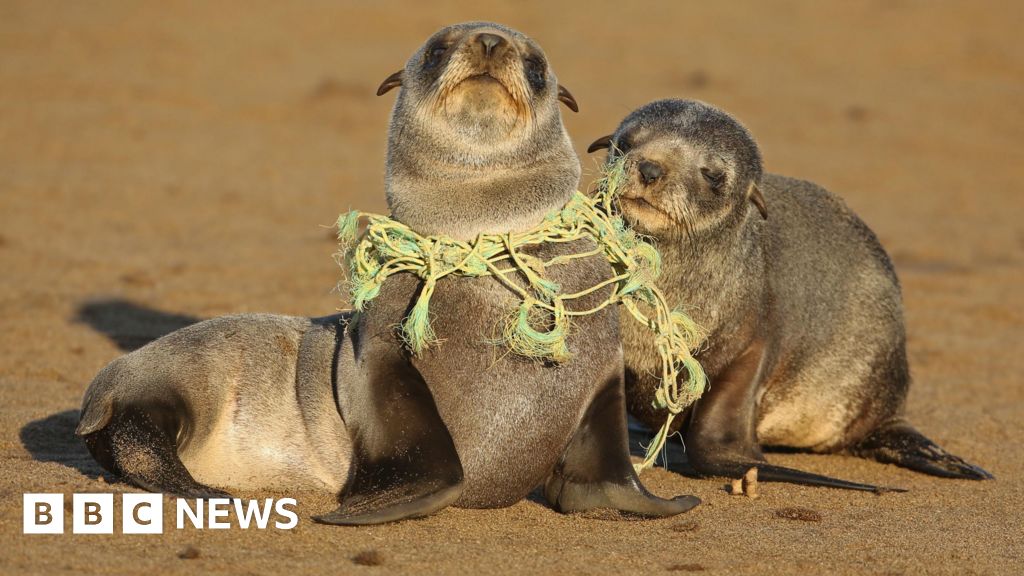Science
Study Reveals Fatal Impact of Plastic on Marine Wildlife

A comprehensive study has unveiled the lethal consequences of plastic ingestion among marine wildlife, based on detailed analyses of 10,000 animal autopsies. Conducted by researchers at the US-based environmental group, Ocean Conservancy, the findings highlight alarming thresholds for seabirds, marine mammals, and sea turtles regarding plastic consumption.
The research indicates that seabirds are particularly vulnerable, facing a staggering 90% chance of death after ingesting merely 23 pieces of plastic. Marine mammals, including seals and dolphins, reach a similar risk level after consuming 29 pieces, while sea turtles can ingest approximately 405 pieces before experiencing similar fatality rates. The study illustrates how surprisingly small amounts of plastic can prove deadly; for instance, a dolphin could perish from less than the volume of a soccer ball made up of soft plastic.
Shocking Discoveries on Plastic Types and Animal Risks
Researchers were taken aback by the findings, particularly regarding the specific types of plastic posing the greatest risks. Seabirds are at heightened risk from rubber, while soft plastics and fishing debris are most hazardous for marine mammals. For sea turtles, both hard and soft plastics present threats. The study focused solely on plastics found within the stomachs of these animals, leaving out considerations of chemical impacts and entanglement, suggesting that the overall harm from plastic pollution is likely more extensive than reported.
The analysis revealed that nearly half of the studied sea turtles, one-third of seabirds, and approximately one in ten marine mammals had consumed plastic. This underscores the pervasive nature of plastic pollution in oceanic environments. Birds frequently ingest plastic fragments, often mistaking them for food, while turtles commonly confuse plastic bags with jellyfish.
Dr. Erin Murphy, the lead researcher, emphasized the urgency of addressing plastic pollution, stating, “It’s a really important reminder that plastic pollution does pose an existential threat to ocean wildlife.” She added, “To effectively address plastic pollution, the science is clear. We need to reduce the amount of plastic we produce, improve collection and recycling, and clean up what’s already out there.”
Future Implications for Conservation Efforts
The research, published in the Proceedings of the National Academy of Sciences, aims to inform and shape global strategies for wildlife protection. By providing precise data on the lethal levels of plastic consumption for various marine species, scientists hope to catalyze more effective conservation initiatives.
As the world grapples with the profound impacts of plastic pollution, this study serves as a crucial reminder of the urgent need to protect marine ecosystems. With hundreds of marine species already documented with plastic in their bodies, the call to action has never been clearer. The fight against plastic pollution is not just about reducing waste; it is also about ensuring the survival of our ocean’s wildlife.
-

 Entertainment3 months ago
Entertainment3 months agoAnn Ming Reflects on ITV’s ‘I Fought the Law’ Drama
-

 Entertainment4 months ago
Entertainment4 months agoKate Garraway Sells £2 Million Home Amid Financial Struggles
-

 Health2 months ago
Health2 months agoKatie Price Faces New Health Concerns After Cancer Symptoms Resurface
-

 Entertainment3 months ago
Entertainment3 months agoCoronation Street’s Carl Webster Faces Trouble with New Affairs
-

 Entertainment2 months ago
Entertainment2 months agoWhere is Tinder Swindler Simon Leviev? Latest Updates Revealed
-

 Entertainment4 months ago
Entertainment4 months agoMarkiplier Addresses AI Controversy During Livestream Response
-

 Science4 weeks ago
Science4 weeks agoBrian Cox Addresses Claims of Alien Probe in 3I/ATLAS Discovery
-

 Entertainment4 months ago
Entertainment4 months agoKim Cattrall Posts Cryptic Message After HBO’s Sequel Cancellation
-

 Entertainment2 months ago
Entertainment2 months agoOlivia Attwood Opens Up About Fallout with Former Best Friend
-

 Entertainment3 months ago
Entertainment3 months agoMasterChef Faces Turmoil as Tom Kerridge Withdraws from Hosting Role
-

 Entertainment4 months ago
Entertainment4 months agoSpeculation Surrounds Home and Away as Cast Departures Mount
-

 World2 months ago
World2 months agoCole Palmer’s Mysterious Message to Kobbie Mainoo Sparks Speculation





















